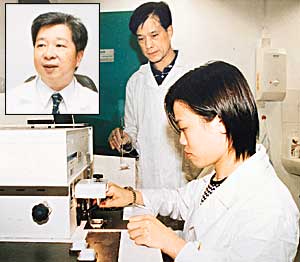Forensic medicine not just the stuff of the X-Files
Some people consider forensic pathology mysterious as it sometimes helps detect crimes which initially have no clues at all.
A good example is a murder case in 1975 in which a woman was killed and her body was stuffed into a box. A man was subsequently found guilty of the murder after analysis and examinations conducted by the Forensic Pathology Service and the Government Laboratory. This was the first case in Hong Kong that a conviction was made based only on forensic evidence.
Consultant Forensic Pathologist In Charge Dr H.K. Mong said their work was not as mysterious as what was depicted in movies and fiction.
 It's elementary!: Medical lab technician Lai Ho-yee (right) and lab attendant Lai Chi-keung put the clues together (above) while Dr Mong (inset) explains the ins and outs of forensics |
"Our work is very professional and independent. We gather evidence using knowledge of clinical forensic medicine and forensic pathology to assist investigations by law-enforcement agencies. We also act as expert witnesses in court," Dr Mong said.
Citing the Garley Building fire on Nathan Road a few years ago as an example, Dr Mong said they had to establish the identities and cause of death of people who were badly burnt to help Police reconstruct the incident.
Forensic pathologists used knowledge of applied medicine to establish the identities of the deceased such as examining their bone marrow to collect information on blood types and DNA-profiling. Forensic pathologists also obtained a clue to the order of death by measuring the concentration of carbon monoxide in their blood. It is well known that forensic pathologists perform autopsies which will confirm the medical cause of death. In the Telford Gardens murders last year, forensic examinations showed that five women were poisoned to death by cyanide. This provided an important clue to investigating officers.
Dr Mong said their work came under a major principle - the Locard Principle, i.e. every contact leaves its trace. In a traffic hit-and-run case, the driver concerned is wrong if he thinks he can get away with it just because the pedestrian has been killed and there are no other eye witnesses. He said: "Forensic pathologists are able to collect information on the type, brand, colour and even production year of the vehicle concerned from the injury marks on the victim's body, glass splinters and other traces left by the vehicle at the scene. This information is useful for Police to look for the culprit. Apart from examining bodies, we also conduct examinations on living individuals. Cases needing such examinations include assaults, child abuse, illegal abortions, sexual offences, etc."
Dr Mong said the role of forensic pathologists was to 'speak for the dead' and protect the rights of those alive.
"To 'speak for the dead' means to ascertain their identities and cause of death. With the application of forensic medicine, forensic pathologists are able to help find out the truth to protect the rights of victims and innocent accused," he said.
On the history of the Forensic Pathology Service in Hong Kong, Dr Mong said because of the increasing demand for their services, the number of forensic pathologists had increased from one in the early 1950s to the present 17. They are all in the Department of Health.
Dr Mong joined the Forensic Pathology Service in 1972 and saw the opening of the then newly-completed May House.
"May House has once been the tallest building in Wan Chai but now it's to be demolished." As for his feelings about his job, Dr Mong said it was full of challenges.
"It enables me to serve the community and at the same time satisfies my curiosity."
<< Back to Index >>